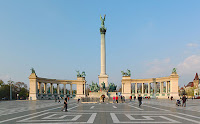While I did buy the usual 'Learn Hungarian' phrasebooks before I arrived in Hungary, the Hungarian language is (apart from very few words) completely unrelated to other European languages (ok, yes, there are some links to Finnish if that helps). But just because it's not related to other languages, don't get discouraged - with a little practice, you can soon be ordering things in shops and asking where the toilet is :-)
Btw, Hungarians are quite proud of how difficult their language is, but they LOVE it when people make the effort to speak Hungarian (ok, ok, I can't guarantee that everyone will love it, but most people will :-)
Anyway, here are some essential words and phrases. I've attempted to add the everyday phonetic version in square brackets [], but it's best to hear it, so I've included a few links to some good YouTube videos below too.
Essential Words
Yes = Igen [ihh-gen]No = Nem [nem]
Thank you = Köszönöm (or köszi for short) [cus-uh-num, cussy] (like the cus in abacus)
Sorry = Boscánat (or bocsi for short) [botch-aa-not, botchy]
Excuse me = Elneszest [el-neh-zesht]
Cheers = Egesegedre [egg-eh-shay-ged-reh]
Essential Phrases
Good day = Jó napot [yo nah-pot]Good evening = Jó éstét [yo esh-tayt]
Hello = Szia [see-ya]
Thank you very much = Köszönöm szépen [cus-uh-num say-pen]
I'm sorry = Sajnálom [shy-nal-om]
I don't speak Hungarian = Nem beszélek magyarul [nem be-say-lek ma-jar-rule]
I only speak a little Hungarian = Beszélek csak egy kicsit magyarul [be-say-lek edge kitch-it ma-jar-rule]
Do you speak English? = Beszélsz angolul? [be-sayl-z an-gol-ool?]
I would like ... = Kerek ... [kay-rek]
Where is the toilet? = Hol van a WC? [hol von ah VC?]
I'm ... = ... vagyok [vadg-ok]
Numbers
1 = egy [see the video below for the pronunciation :-)]2 = kettö (or két for short)
3 = három
4 = négy
5 = öt
6 = hat
7 = hét
8 = nyolc
9 = kilenc
10 = tíz
There are of course hundreds of words and phrases you could learn, and if you're staying for more than a few weeks, then I would recommend studying them a bit.
If you're staying for a long time, then I should add that I took a month long intensive course in Hungarian at Ulysses Language School (http://www.ulysses.co.hu/en/), and I can absolutely recommend that. It cost about €250-300 but it was everyday and by the end of the course I found that I really could understand so much more.
Anyway, people, have fun with speaking Hungarian, and don't worry if you get it wrong - just trying will score lots of points with the locals :-)
Those Hungarian Language YouTube Videos
Greetings: https://www.youtube.com/watch?v=6-NIOJ62hzg




